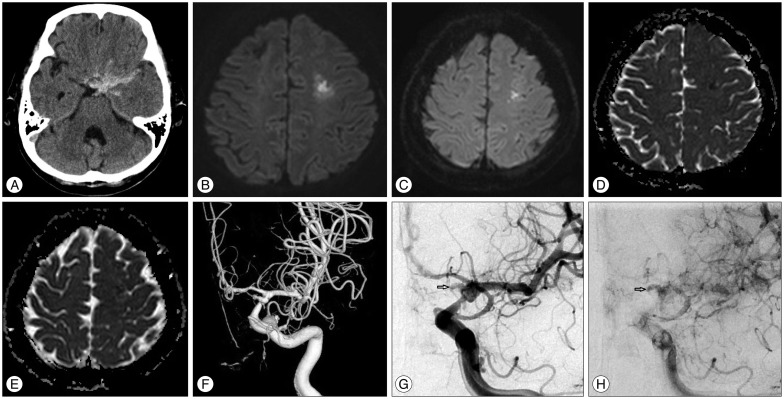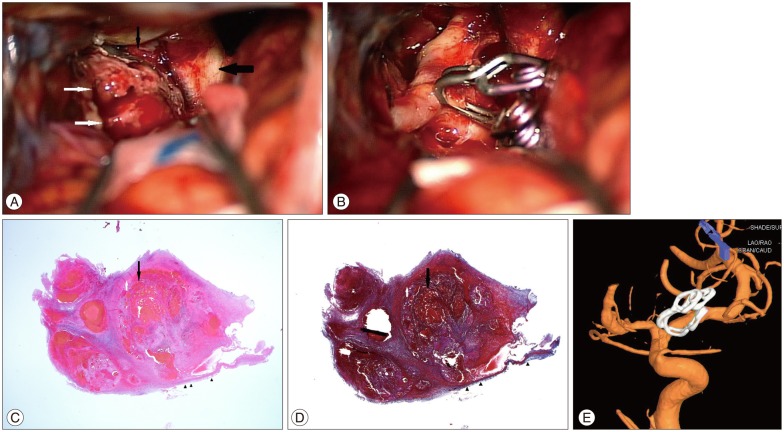J Korean Neurosurg Soc.
2015 Aug;58(2):137-140. 10.3340/jkns.2015.58.2.137.
Concurrent Ruptured Pseudoaneurysm of the Internal Carotid Artery and Cerebral Infarction as an Initial Manifestation of Polycythemia Vera
- Affiliations
-
- 1Department of Neurosurgery, Hanyang University Guri Hospital, College of Medicine, Hanyang University, Guri, Korea. kjm2323@hanyang.ac.kr
- 2Department of Pathology, Hanyang University Guri Hospital, College of Medicine, Hanyang University, Guri, Korea.
- KMID: 2191322
- DOI: http://doi.org/10.3340/jkns.2015.58.2.137
Abstract
- The most common neurologic manifestations of polycythemia vera (PV) are cerebral infarction and transient ischemic attacks, while cerebral hemorrhage or intracranial dissection has been rarely associated with PV. Here we report the first case of a 59-year-old patient with intracranial supraclinoid internal carotid artery (ICA) dissection causing cerebral infarction and concomitant subarachnoid hemorrhage due to pseudoaneurysm rupture as clinical onset of PV. This case report discusses the possible mechanism and treatment of this extremely rare condition.
Keyword
MeSH Terms
Figure
Cited by 1 articles
-
Acquired von willebrand syndrome in patients with Philadelphia-negative myeloproliferative neoplasm
Ik-Chan Song, Sora Kang, Myung-Won Lee, Hyewon Ryu, Hyo-Jin Lee, Hwan-Jung Yun, Deog-Yeon Jo
Blood Res. 2023;58(1):42-50. doi: 10.5045/br.2023.2022218.
Reference
-
1. Garaci FG, Gandini R, Romagnoli A, Fasoli F, Varrucciu V, Simonetti G. Hepatic artery pseudoaneurysm in von Willebrand's disease. Eur Radiol. 2003; 13:1913–1915. PMID: 12942294.
Article2. Gupta PK, Kannan M, Chatterjee T, Dixit A, Mahapatra M, Choudhry VP, et al. Acquired von Willebrand's disease associated with gastrointestinal angiodysplasia : a case report. Haemophilia. 2006; 12:452–455. PMID: 16834752.
Article3. Michiels JJ, Berneman Z, Schroyens W, Koudstaal PJ, Lindemans J, Neumann HA, et al. Platelet-mediated erythromelalgic, cerebral, ocular and coronary microvascular ischemic and thrombotic manifestations in patients with essential thrombocythemia and polycythemia vera : a distinct aspirin-responsive and coumadin-resistant arterial thrombophilia. Platelets. 2006; 17:528–544. PMID: 17127481.
Article4. Mohri H. Acquired von Willebrand syndrome : its pathophysiology, laboratory features and management. J Thromb Thrombolysis. 2003; 15:141–149. PMID: 14739623.
Article5. Nakatomi H, Segawa H, Kurata A, Shiokawa Y, Nagata K, Kamiyama H, et al. Clinicopathological study of intracranial fusiform and dolichoectatic aneurysms : insight on the mechanism of growth. Stroke. 2000; 31:896–900.
Article6. Pearson TC. Hemorheologic considerations in the pathogenesis of vascular occlusive events in polycythemia vera. Semin Thromb Hemost. 1997; 23:433–439. PMID: 9387202.
Article7. Gruppo Italiano Studio Policitemia. Polycythemia vera : the natural history of 1213 patients followed for 20 years. Ann Intern Med. 1995; 123:656–664. PMID: 7574220.
- Full Text Links
- Actions
-
Cited
- CITED
-
- Close
- Share
- Similar articles
-
- 28-year old Polycythemia Vera patient presenting with Cerebral Infarction
- Recurrent Cerebral Infarction in Polycythemia Vera
- Acute Cerebral Infarction Associated With Polycythemia Vera
- Carotid Vessel Wall MRI Findings in Acute Cerebral Infarction Caused by Polycythemia Vera: A Case Report
- A Case of Polycythemia Vera Presenting as an ST-Elevation Myocardial Infarction



